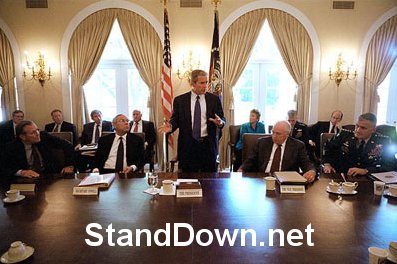
Private Plane Flew Too Close To The White House
U.S. Air Force Jets Intercept Private Plane Straying Near White House
...and as per standard operating procedure:
The fighters were scrambled from nearby Andrews Air Force Base in Maryland
and they intercepted the plane, escorting it out of the area, she said.
Secret
Service Hides Cheney As Plane Enters Restricted Area
...and
as per standard operating procedure:
The
plane was intercepted by two Air Force F-16 fighters, whose pilots
determined that it was not a threat and escorted it out of the area.
Other
Planes That Flew Too Close To The White House
Cessna 182 Flew Too Close To The White House
cessna182flewtooclosetothewhitehouse.htm
Frontier
737 Flew Too Close To The White House
frontier737flewtooclosetothewhitehouse.htm
U.S. Air Force Jets Intercept Private Plane
Straying Near White House
Terrance Hunt, Canadian Press, November
10, 2003
WASHINGTON (AP) - Air force fighter jets scrambled Monday to intercept
a private plane that flew too close to the White House, triggering a security
scare that led Vice-President Dick Cheney and President George W. Bush's
chief of staff to be moved to a secure location.
The plane was later determined not to be a threat. The president was away at the time, on a trip to Arkansas and South Carolina, and his wife, Laura, had a speaking engagement in Maine.
Cheney and White House Chief of Staff Andrew Card were moved temporarily as a precautionary measure, said presidential spokesman Scott McClellan. They resumed their normal routines soon thereafter, said McClellan, who was with Bush in Little Rock, Ark.
The plane was detected flying down the Potomac River toward Washington when it entered restricted airspace, said Secret Service spokeswoman Jean Mitchell.
The fighters were scrambled from nearby Andrews Air Force Base in Maryland and they intercepted the plane, escorting it out of the area, she said.
"He was within eight miles (13 kilometres)" of the White House, she said. "It's enough to affect our emergency response plan." Armed officers took up positions on the White House lawn during the incident.
The air force jets peeled off when the plane left restricted airspace but it was tracked on radar until it landed in Siler City, N.C., for refuelling, said Dan Dluzneski, another Secret Service spokesman. The pilot allowed authorities to search the plane, and told Secret Service officers that he had been unable to contact the fighter jets.
"As far as the Secret Service is concerned, it's closed," said Dluzneski. He said the pilot had purchased the plane and had it serviced in Pennsylvania over the weekend and was flying it to Florida. "He thought he was abiding by the flight restrictions. Obviously he was not," Dluzneski said. He declined to identify the pilot.
Maj. Douglas Martin, spokesman for the North American Aerospace Defence Command, or Norad, said it had been determined the plane was not a threat.
"From the Norad perspective, he's not a threat, and that's the main thing for us," Martin said.
The
plane apparently strayed within the Air Defence Identification Zone, roughly
a 37-kilometre radius around Washington, according to Les Dorr, spokesman
for the Federal Aviation Administration.
Source: http://www.canada.com/news/world/story.asp?id=B2195768-81B7-4EA5-A60C-77BCEF7EA677
Secret Service Hides Cheney As Plane Enters Restricted Area
by Richard W. Stevenson, The New York Times,
November
11, 2003
WASHINGTON, Nov. 10 — The Secret Service hustled Vice President Dick Cheney into a secure site on Monday morning after a small plane flew into restricted airspace around Washington, government officials said.
The plane was intercepted by two Air Force F-16 fighters, whose pilots determined that it was not a threat and escorted it out of the area.
President Bush was on his way to a fund-raiser in Little Rock, Ark., at the time, and Laura Bush was in Maine.
Mr. Cheney returned to work in the White House after a short time, said a Secret Service spokesman, Tom Mazur.
Mr. Mazur said Andrew H. Card Jr., the White House chief of staff, was also taken to the undisclosed secure spot while the Air Force sought to determine whether the small plane presented any danger.
Officials said the plane, a single-engine Mooney M20, entered the restricted zone, within 17.5 miles of the Washington Monument, about 11:15 a.m. Mr. Mazur said the pilot of the small plane cooperated with the instructions of the fighter pilots and was allowed to go on his way.
The restricted airspace was established after the terrorist attacks of Sept. 11, 2001, to help protect the White House and other government buildings in Washington.
Officials said the plane proceeded on to Siler City, N.C., where an airport official said it landed about noon.
The Secret Service later said it had searched the plane and not found any weapons.
Jean Mitchell, a spokeswoman for the Secret Service, said the pilot had thought he was abiding by the flight restrictions around Washington, not realizing they had been changed after the terrorist attacks. Ms. Mitchell said the pilot, whom she would identify only as a white male, was flying to Florida from Pennsylvania. She said the Secret Service was satisfied that he had not intended harm to Mr. Bush or the White House.
The incident was the second security scare for the administration in a little more than a week. On Nov. 1, a woman drove a car through a security cordon outside an arena in Mississippi where Mr. Bush had just finished speaking. She crashed her car near where the president had just gotten into his limousine, but the Secret Service later determined that she had not intended to try to hurt Mr. Bush.
A spokesman for the Federal Aviation Administration, William A. Shumann, said the Mooney M20, a four-seat, low-wing plane with retractable landing gear, was, "by general aviation standards, a fairly hot airplane."
Mr.
Shumann said the punishment for violating the restricted airspace could
range from a letter of reprimand to a temporary suspension of a pilot's
license to revocation of the license.
Source: http://www.nytimes.com/2003/11/11/national/11PLAN.html
Back to: StandDown.net
